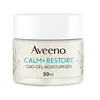REN Clean Skincare ClearCalm 3 Replenishing Gel Cream For Blemish Prone Skin Versus Aveeno Calm + Restore Oat Gel Moisturizer
What's inside
What's inside
 Key Ingredients
Key Ingredients

 Benefits
Benefits

 Concerns
Concerns

 Ingredients Side-by-side
Ingredients Side-by-side

Water
Skin ConditioningCetearyl Alcohol
EmollientOleyl Alcohol
EmollientGlycerin
HumectantButyrospermum Parkii Butter
Skin ConditioningGlycine Soja Oil
EmollientLauryl Laurate
Skin ConditioningMyristyl Myristate
EmollientCetearyl Glucoside
EmulsifyingAlcohol Denat.
AntimicrobialOryzanol
Skin ConditioningCaprylic/Capric Triglyceride
MaskingVaccinium Macrocarpon Seed Oil
Skin ConditioningVaccinium Vitis-Idaea Seed Oil
AntioxidantCarbomer
Emulsion StabilisingLavandula Angustifolia Oil
MaskingPelargonium Graveolens Flower Oil
MaskingSalvia Officinalis Oil
MaskingTocopherol
AntioxidantLactic Acid
BufferingAnthemis Nobilis Flower Oil
MaskingPueraria Lobata Symbiosome Extract
AntioxidantCassia Alata Leaf Extract
AstringentPhenoxyethanol
PreservativeSodium Hydroxymethylglycinate
PreservativeGlycyrrhiza Glabra Root Extract
BleachingLaminaria Ochroleuca Extract
Skin ConditioningHelianthus Annuus Seed Oil
EmollientRosmarinus Officinalis Leaf Extract
AntimicrobialCitronellol
PerfumingGeraniol
PerfumingLimonene
PerfumingLinalool
PerfumingWater, Cetearyl Alcohol, Oleyl Alcohol, Glycerin, Butyrospermum Parkii Butter, Glycine Soja Oil, Lauryl Laurate, Myristyl Myristate, Cetearyl Glucoside, Alcohol Denat., Oryzanol, Caprylic/Capric Triglyceride, Vaccinium Macrocarpon Seed Oil, Vaccinium Vitis-Idaea Seed Oil, Carbomer, Lavandula Angustifolia Oil, Pelargonium Graveolens Flower Oil, Salvia Officinalis Oil, Tocopherol, Lactic Acid, Anthemis Nobilis Flower Oil, Pueraria Lobata Symbiosome Extract, Cassia Alata Leaf Extract, Phenoxyethanol, Sodium Hydroxymethylglycinate, Glycyrrhiza Glabra Root Extract, Laminaria Ochroleuca Extract, Helianthus Annuus Seed Oil, Rosmarinus Officinalis Leaf Extract, Citronellol, Geraniol, Limonene, Linalool
Water
Skin ConditioningGlycerin
HumectantDimethicone
EmollientCetearyl Olivate
Avena Sativa Kernel Flour
AbrasiveAvena Sativa Kernel Extract
AbrasiveChrysanthemum Parthenium Flower/Leaf/Stem Juice
AntioxidantEthylhexylglycerin
Skin ConditioningPentylene Glycol
Skin ConditioningC13-14 Isoparaffin
EmollientPolyacrylamide
Dimethiconol
EmollientSorbitan Olivate
EmulsifyingSynthetic Beeswax
Emulsion StabilisingLaureth-7
EmulsifyingDimethicone Crosspolymer
Emulsion StabilisingCarbomer
Emulsion StabilisingSodium Hydroxide
BufferingCitric Acid
BufferingSodium Metabisulfite
AntioxidantBHT
AntioxidantPhenoxyethanol
PreservativeChlorphenesin
AntimicrobialSodium Benzoate
MaskingPotassium Sorbate
PreservativeWater, Glycerin, Dimethicone, Cetearyl Olivate, Avena Sativa Kernel Flour, Avena Sativa Kernel Extract, Chrysanthemum Parthenium Flower/Leaf/Stem Juice, Ethylhexylglycerin, Pentylene Glycol, C13-14 Isoparaffin, Polyacrylamide, Dimethiconol, Sorbitan Olivate, Synthetic Beeswax, Laureth-7, Dimethicone Crosspolymer, Carbomer, Sodium Hydroxide, Citric Acid, Sodium Metabisulfite, BHT, Phenoxyethanol, Chlorphenesin, Sodium Benzoate, Potassium Sorbate
 Reviews
Reviews

Ingredients Explained
These ingredients are found in both products.
Ingredients higher up in an ingredient list are typically present in a larger amount.
Carbomer is a polymer of acrylic acid. Its main role is to create a gel consistency.
A high amount of carbomer can cause pilling or balling up of products. Don't worry, most products contain 1% or less of carbomer.
Glycerin is already naturally found in your skin. It helps moisturize and protect your skin.
A study from 2016 found glycerin to be more effective as a humectant than AHAs and hyaluronic acid.
As a humectant, it helps the skin stay hydrated by pulling moisture to your skin. The low molecular weight of glycerin allows it to pull moisture into the deeper layers of your skin.
Hydrated skin improves your skin barrier; Your skin barrier helps protect against irritants and bacteria.
Glycerin has also been found to have antimicrobial and antiviral properties. Due to these properties, glycerin is often used in wound and burn treatments.
In cosmetics, glycerin is usually derived from plants such as soybean or palm. However, it can also be sourced from animals, such as tallow or animal fat.
This ingredient is organic, colorless, odorless, and non-toxic.
Glycerin is the name for this ingredient in American English. British English uses Glycerol/Glycerine.
Learn more about GlycerinPhenoxyethanol is a preservative that has germicide, antimicrobial, and aromatic properties. Studies show that phenoxyethanol can prevent microbial growth. By itself, it has a scent that is similar to that of a rose.
It's often used in formulations along with Caprylyl Glycol to preserve the shelf life of products.
Water. It's the most common cosmetic ingredient of all. You'll usually see it at the top of ingredient lists, meaning that it makes up the largest part of the product.
So why is it so popular? Water most often acts as a solvent - this means that it helps dissolve other ingredients into the formulation.
You'll also recognize water as that liquid we all need to stay alive. If you see this, drink a glass of water. Stay hydrated!
Learn more about Water